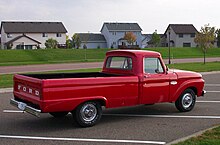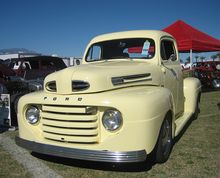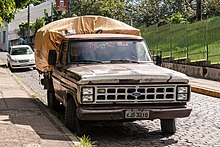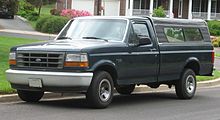Ford F series
The F-Series from Ford is a range of pick-ups , buses and lorries from the Ford Motor Company that has been available in its thirteenth generation since 1948 . The vehicle has been the best-selling car in the USA for 32 years (as of 2014) and, with a total of 34 million units produced, ranks second behind the Toyota Corolla (as of May 2010).
history
The first generation of the F-series came out in 1948 with three different models. 66 years later, Ford brought the current 13th generation (see photo bar on the right) of the pickup model onto the market. The F-Series is the backbone of the Ford Motor Company in the home market of the USA . For years it has been the best-selling vehicle in the North American market. In autumn 2008 it was pushed out of the top of the registration statistics for the first time by the Honda Civic, but over the entire year, the Ford F-Series continued to lead the registration statistics.
The basis of the success is the countless body and equipment variants available as well as the affordable prices, which start at 17,345 US dollars. The model is available with a driver's cab of different sizes, different wheelbases and several engine and drive train combinations. Diesel engines are traditionally reserved for pickups of the heavy-duty or super-duty range Ford F-250/350.
The models are also popular due to their high payload (up to 1400 kg for F-150 and 2600 kg for F-350) and the high trailer load (up to 5000 kg for F-150 and 8700 kg for F-350).
The large dimensions (up to 6.6 m in length, 2.4 m in width and 2 m in height) of the vehicle in combination with its fuel-intensive engines (between 21 l / 100 km to 25 l / 100 km depending on the driving style) and a high Dead weight of up to 3 t has kept the Ford Motor Company from exporting to the European markets.
Until the appearance of the Dodge Ram SRT-10, the F-150 SVT Lightning was considered the fastest series pickup in the world.
The generations
Generation one
The first generation of the F-series appeared in 1948, then referred to as the Ford F-1 . The model replaced car-based pickups at Ford at that time. The F-series was available in a total of eight versions, which were named F-1 to F-8 based on their gross vehicle weight. In Canada, the model was also sold under the Mercury brand. The car was already being built in sixteen Ford plants in the USA. The engine consisted of in-line six-cylinder and V8 engines with 3.5 to 5.5 liters displacement.
In 1951, the model got a slightly redesigned radiator grille with large vertical struts, and the headlights were further attached to the side of the wheel arches.
Generation two
In 1953 a completely revised pickup followed with a much wider radiator grille into which the headlights were integrated. The designation scheme was changed to F-100 for the basic version and similar numbers up to F-360 , with higher numbers generally indicating a higher payload. The largest models of the first generation, F-5 to F-8 , had no successor for the time being, so there were only in-line six-cylinder and V8 engines with a maximum displacement of 4.5 liters. The Mercury model was now also offered in the USA, and the models were also built in Brazil from 1957 to 1962. A total of 505,184 copies of the second generation were built, 25,122 of which were long beds.
Generation three
In 1957, a completely new model followed in North America with a significantly more angular body and a full-width hood. In addition, there was a version called styleside in which the loading area ended exactly at the side with the driver's cab. In contrast to the passenger car sector at the time, the F-series dispenses with extensive chrome jewelry. As with the second generation, models with a high total weight were dispensed with. There were three different engines - an in-line six-cylinder with 3.7 liters displacement and two V8 engines with 4.5 and 4.7 liters displacement. Production was limited to eleven different locations, the F-350 now only rolled off the assembly line in Louisville , where the largest models of the F-series are still produced today.
This model was also manufactured in Brazil after it was discontinued in the USA, this time until 1971.
Generation four
A fourth, completely redesigned generation followed in 1961 in the USA. For the first time, F-Series vehicles were produced for the North American market outside the United States: In Cuautitlán ( Mexico ) and Oakville ( Canada ). A double cabin was introduced for the first time in 1965 . In addition, there was a version specially designed as a basis for comparatively heavy caravan bodies. The engine range was expanded to include a 5.8-liter V8 with 128 kW.
Generation five
The fifth generation, introduced in 1967, was extremely angular in line with the fashion of the time. Since side lighting or reflectors had to be attached to all vehicles in the USA from 1968 onwards, Ford designed the emblems attached to the side of the bonnet with integrated reflectors. As a Ford Ranger there was a luxury version for the first time. In addition, there were various special versions for a wide variety of purposes in relatively small numbers. Now V8 engines with up to 6.4 liters and 190 kW have been installed.
In Brazil, this model inherited - once again at its end in the USA - the third generation in 1971 and remained in production until 1992.
Generation six
The sixth generation, which was introduced in the USA in 1973, remained without any fundamental innovations, but this model was the best-selling pickup in the USA in 1976, a position that the F-Series still holds today. It also formed the basis of the new generation of Ford Bronco models introduced in 1978 . One of the most striking things about it is the “FORD” lettering in large chrome letters above the radiator grille. So far, Ford has held back with brand features. In addition to two in-line six-cylinders, there were six different V8 engines with a displacement of up to 7.5 liters.
Generation seven
In 1980, the entire vehicle design was more angular and optimized for lower air resistance and thus lower fuel consumption. The grille had a rough honeycomb pattern with (from 1982) the modern Ford logo in its center. With this generation, Ford built an all-wheel-drive vehicle with a front independent suspension for the first time, and body parts were galvanized for the first time to protect against corrosion . From the end of 1983 the smallest version was no longer called the F-100, but the F-150 . The Ford Ranger was an independent model from 1982 and replaced the second generation of the Ford Courier . From 1982 there was the model with a V6 engine instead of the ancient in-line six-cylinder, but this engine did not catch on and was withdrawn from the range at the end of 1983. A new 6.9-liter diesel V8, on the other hand, had a longer future.
Generation eight
With the eighth generation in 1987, the design changed significantly. The turn signals, which had previously been hidden on the side, were moved to the corners of the vehicle and instead of a lot of chrome there was now black plastic. For the first time, a pickup had a standard anti-lock braking system for the rear wheels. In addition, the 4.9-liter engine received an electronic injection system instead of a carburetor .
In 1988, the 6.9-liter diesel engine was replaced by a 7.3-liter diesel V8 with an output of 130 kW. The petrol engines with 5.8 and 7.5 liter displacement now also had an injection system, so that Ford no longer offered carburettor engines in the F series.
For the first time there was its own version, the F-Super Duty , which was significantly larger than the basic version and had twin tires on the rear axle. The model was powered by the 7.4-liter V8 or the 7.3-liter diesel V8.
Generation nine
The ninth generation followed in 1992, the front was made smoother and therefore more aerodynamic. The revision continued in the interior with a redesigned dashboard. The Super Duty remained the previous version.
Some technical changes were made for the 1994 model year. In addition to a side airbag for the driver, there was now a third brake light and a CFC- free air conditioning system. Radio remote control, alarm system, CD radio and an electrically adjustable driver's seat were optionally available.
In 1994, the 7.3 liter diesel engine was revised, thanks to a turbocharger and direct injection it now developed 175 kW and delivered 576 Nm of torque.
Generation ten
The tenth generation, introduced in 1996, received the largest visual makeover in a long time. A slightly rounded front made the vehicle appear much more aerodynamic. The engine range was radically revised and reduced to three engines - a V6 with a displacement of 4.2 liters and two V8s with a displacement of 4.6 and 5.4 liters. So there was no diesel engine and even after almost fifty years there were no more in-line six-cylinder engines.
The Super Duty was introduced as an independent model in the following model year and in the course of this the basic model was only built as a pickup, no longer as a chassis cab . In the 1997 model year, an F-250 was therefore offered. From the 1998 model year, all models above the F-150 were only available as Super Duty.
The SVT Lightning was revived for the 1999 model year. This time with a 5.4 l compressor engine and 268 kW.
Generation eleven
The eleventh generation of 2004 brought further visual modernizations.
The basic model with a 4.2-liter V6 engine and manual transmission was only available for corporate customers' vehicle fleets when it was launched; until 2005, normal buyers could only choose between two V8 engines with a displacement of 4.6 or 5.4 liters and four-speed -Choose automatic transmission. The 5.4 liter engine was a new development with three-valve technology.
From the 2006 model year there was a flex-fuel version of the 5.4-liter engine that could be refueled with bioethanol. In addition, the front bumper was equipped with round fog lights, there were other front seats with more lateral support and new 20-inch alloy wheels. For the first time, a navigation system was offered as an option.
The generation achieved the highest ratings of 5 stars in frontal impacts in the NHTSA crash tests .
Generation twelve
From autumn 2008 the heavily redesigned F-150 was available from American dealers. Like its two predecessors, this model generation also received the North American Truck of the Year award in 2009 .
This model generation of the F-150 was no longer built with a manual gearbox; however, it was still offered on the F-250 and F-350 super-duty models. In addition to a 4.6-liter V8 engine, which was available in two versions with 185 kW or 218 kW, a 5.4-liter V8 engine with an output of 230 kW was offered. This engine, slightly revised, was also available in an E85- compatible version with an output of 240 kW.
In addition, the safety equipment was significantly improved; For the first time, an ESP was installed in a pick-up of this size , which also has automatic roll stability control (RSC) - a system that Ford offers in almost all US models. In addition, the twelfth generation had side airbags for the driver and front passenger, as well as head-shoulder airbags for the passengers in the first and second row of seats.
The engine range has been completely revised for the 2011 model year; all previously available engines were omitted. There was now a new V6 engine with a displacement of 3.7 liters (225 kW) and a V8 with a displacement of 5 liters (270 kW). Both engines came from the current Ford Mustang and were E85- compatible. There was also the 6.2-liter V8 engine with 306 kW known from the super-duty models.
In the spring of 2011, Ford introduced a new, turbocharged Ecoboost V6 engine with a displacement of 3.5 liters, which had 272 kW with almost the same gasoline consumption (around 20 percent more than the 3.7-liter V6 engine that is still available).
Generation thirteen
The thirteenth generation has been available in stores since December 2014. The first mass-produced vehicle was completed on November 11, 2014 in Dearborn.
This generation is based on the concept of the Ford Atlas. The use of aluminum alloys and high-strength steels results in a weight saving of up to 350 kg compared to the 2.5-ton predecessor. The additional material cost for the aluminum body is estimated at $ 1,000 to $ 1,500 per vehicle. The amount of aluminum required annually is 350,000 tons, so according to supplier Alcoa , Ford processes more aluminum for this model than the entire European vehicle industry combined. The large order to the suppliers Alcoa and Novelis used their rolling mills to capacity and there was a shortage of aluminum on the world market .
Four different engines will be offered initially. The entry-level engine will be a newly developed 3.5-liter V6 petrol engine, and a newly developed 2.7-liter V6 petrol engine from the EcoBoost engine series will be available, which has an output of 239 kW (325 hp) and 500 Nm of torque. The other two engines - the 5.0-liter V8 engine and the 3.5-liter EcoBoost V6 - are carried over from the predecessor.
For the first time for a pickup, Ford will be offering optional LED headlights and a frameless window for the rear wall of the driver's cab.
After a complete conversion of the factory, this generation will initially only be produced in the Dearborn Truck Plant in Dearborn . Subsequently, the production of the predecessor in the Kansas City Assembly Plant in Claycomo ( Clay County, Missouri ) will be shut down in order to convert this plant afterwards as well. Ford plans to produce up to 850,000 vehicles in the first year of production.
Authority version
Ford announced the first pickup truck specifically built for police use in the range. In the official version of the F-150, an FX4 off-road chassis, Goodyear Wrangler tires and a 240 amp alternator were installed on a twin-turbo V6 engine.
Body versions
| Regular Cab | Great cab | Great crew | ||||
|---|---|---|---|---|---|---|
| Loading area | 6.5 ft 1981 mm |
8.0 ft 2438 mm |
6.5 ft 1981 mm |
8.0 ft 2438 mm |
5.0 ft 1524 mm |
6.5 ft 1981 mm |
| Length × width × height | 5316 mm × 2029 mm × 1918 mm | 5789 mm × 2029 mm × 1908 mm | 5890 mm × 2029 mm × 1918 mm | 6362 mm × 2029 mm × 1918 mm | 5890 mm × 2029 mm × 1920 mm | 6190 mm × 2029 mm × 1923 mm |
| wheelbase | 3109 mm | 3584 mm | 3683 mm | 4158 mm | 3683 mm | 3983 mm |
Length of loading area calculated in mm (1 ft = 304.8 mm)
Technical specifications
| 2.7 V6 EcoBoost | 3.5 V6 EcoBoost | HO 3.5 V6 EcoBoost | 3.5 Ti-VCT V6 | 5.0 Ti-VCT V8 | ||
|---|---|---|---|---|---|---|
| Construction period | since 2014 | 2014-2016 | since 2016 | since 2014 | ||
| Engine characteristics | ||||||
| Engine type | V6 turbo gasoline engine | V6 petrol engine | V8 petrol engine | |||
| Displacement | 2694 cc | 3507 cc | 3490 cc | 4948 cc | ||
| Max. Power at min −1 | 242 kW (329 hp) / 5750 | 272 kW (370 hp) / 5000 | 280 kW (381 PS) / 5000 | 336 kW (457 PS) / 5000 | 210 kW (286 PS) / 6250 | 287 kW (390 PS) / 5750 |
| Max. Torque in min -1 | 508 Nm / 3000 | 570 Nm / 2500 | 640 Nm / 3500 | 691 Nm / 3500 | 346 Nm / 4000 | 525 Nm / 3850 |
| Power transmission | ||||||
| Drive, as standard | Rear wheel drive | |||||
| Drive, optional | all wheel drive | |||||
| Gearbox, as standard | 6- speed automatic transmission | 10-speed automatic transmission | 6-speed automatic transmission | |||
| Readings | ||||||
| Top speed | k. A. | 170 km / h (regulated) | 170 km / h (regulated) | |||
| Acceleration, 0-100 km / h | 6.3 s | k. A. | 5.1 s | k. A. | ||
Super duty
In addition to the F-150 to F-350, there has been an F-Super Duty model since the eighth generation, which is positioned well above this in terms of price. The Ford Super Duty has been its own model since the tenth generation , including the F-250 and above. In some Asian countries the series is also known as Ford Western ; its first generation was manufactured at Ford Vietnam .
Generation 1
The first generation of the Super Duty as a separate model was presented in 1998. There were the types F-250, F-350 and F-550. In 2005 the model received a facelift.
Generation 2
The second generation of the Super Duty appeared in 2008, together with the visually clearly different F-150 of the twelfth generation. There were the types F-250, F-350, F-450 and F-550. From 2008 the 6.4-liter Powerstroke engine with bi-turbo was offered, which developed 261 kW (355 hp) and a maximum torque of 881 Nm.
Generation 3
In 2011 the third generation was launched, the design of which was primarily characterized by a new, larger front. The interior looked higher quality than in the second generation and a new equipment line Platinum was offered, which represented almost the full equipment. These models were externally recognizable by their own radiator grille, a lettering on the side of the load compartment walls and a thick, raised, silver stripe that ran across the tailgate. The equipment variants XL, XLT, Lariat and King Ranch were also available.
The engines have also been revised. The 6.4 liter Power Stroke V8 diesel engine was replaced by a Power Stroke V8 diesel engine with a displacement of 6.7 liters, which developed 291 kW (396 hp) and a maximum torque of 997 Nm. After a year, the output was increased to 298 kW (405 hp) and a maximum torque of 1,084 Nm. There were also two different gasoline engines available for the third super-duty generation. The 5.4 liter Triton V8 engine was replaced by an E85-compatible 6.2 liter Boss V8 engine with 287 kW (390 hp). The second petrol engine, a 6.8-liter Triton V10 engine, was taken over unchanged, but was now only available for the F-450 and F-550 models.
A technically revised 6.7-liter power stroke diesel engine has been installed since model year 2015 ; Thanks to a larger turbocharger, it delivers up to 328 kW (446 hp) and 1,170 Nm of torque.
Medium duty

The Medium Duty range currently includes the F-650 and F-750 variants, and previously the F-500, F-600, F-700 and F-12000 variants (only in South America). In contrast to the smaller versions from Ford, they are only available as chassis cabs .
F-650 super truck
The tuning company SuperTruck in Augusta (Georgia) offers pickup conversions based on the F-650 chassis.
Web links
Individual evidence
- ↑ http://www.nydailynews.com/autos/auto-sales-reach-six-year-high-demand-peaked-article-1.1567645
- ↑ http://www.autoexpress.co.uk/news/autoexpressnews/252037/five_topselling_cars_in_the_world.html
- ↑ Ford's F-Series sets industry truck sales records ( Memento from December 6, 2012 in the web archive archive.today ) Ford-trucks.com, January 4, 2006
- ↑ US car market: fuel guzzlers still popular spiegel.de, 7 January 2009
- ^ Robert Ackerson: Ford F-100 / F-150 Pickup 1953-1996: America's Best-Selling Truck . Veloce Pub, 2005, ISBN 978-1-904788-76-8 .
- ^ Detroit Free Press. Retrieved November 12, 2014 .
- ↑ BUYER'S GUIDE 2015 Ford F-150 First Look motortrend.com, January 12, 2014, accessed July 13, 2017
- ↑ Steel Times International Vol. 38 No. 8 (p. 23)
- ↑ a b Tom Grünweg: Ford F-150 with aluminum body: The fat man has slimmed down. Spiegel-Online , January 18, 2015, accessed January 18, 2015 .
- ↑ Engine program 2015 F150. ford.com, accessed October 30, 2014 .
- ↑ The new 2.7L Ecoboost in the 2015 F150. ford.com, accessed October 30, 2014 .
- ↑ new technologies in the 2015 F150. ford.com, accessed October 30, 2014 .
- ↑ Frameless window. ford.com, accessed October 30, 2014 .
- ↑ Video DTP factory conversion. Retrieved October 30, 2014 .
- ^ History Of American Police Cars. October 7, 2019, accessed June 2, 2020 (American English).
- ↑ Homepage























